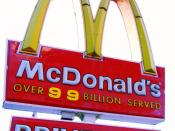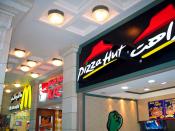"The rise of the fast-food industry transformed American eating habits in the second half of the twentieth century" (Schlosser 8). Almost everywhere you look you'll see a familiar sign symbolizing our "fast food nation." You find them in airports, malls, schools, and gas stations, on the corners of streets, off the side of interstates, near your local shopping center, and even in hospitals. There is no way of getting around them. In 1970 Americans spent $6 billion on french fries alone; the year 2000, Americans spent over $110 billion (Gingras np). During any given day of the week, 3 out of 4 children eat fast food meals (one or more) times a day, which is the foundation of harmful effects to mind and body of any child (Schlosser np). The fast food industry has created an epidemic of obesity that reaches and affects the lives of millions, everywhere and of every age.
In the 1970's, Americans spent a quarter of their food dollar eating out. Today, that figure has topped 40 percent (Greenblatt np). Americans now spend more money on fast food than they do on higher education, personal computers, software or new cars. They spend more on fast food than on movies, books, magazines, newspapers, videos and recorded music - combined (Krantz np). The fast food industry, which began as a vision of a pioneer, has transformed into a new paradigm where children are endangered by the harmful physical, emotional, and psychological effects of unhealthy food and targeted advertising.
In 1954, a fifty-two-year-old milkshake machine salesman saw a hamburger stand in San Bernardino, California, and envisioned a massive new industry: fast food. In what should have been his golden years, Raymond Kroc, the founder and builder of McDonald's Corporation, proved himself an industrial pioneer, in the ranks of...



Holy s***
Wow fast food needs to slow down a lot or we need to have a big change and stop going as often...!!!
1 out of 1 people found this comment useful.